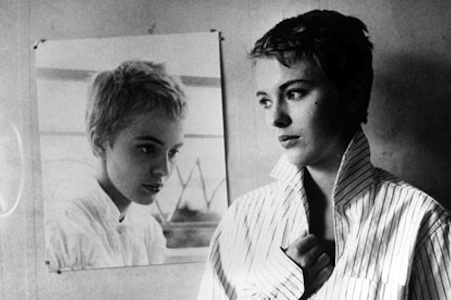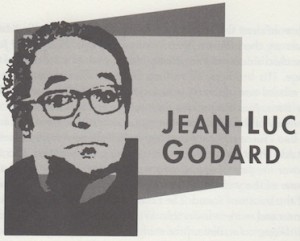Born: December 3, 1930, Paris, France
He’s the definitive influence, if not really the first film artist, of the last decade.
—Orson Welles
In 1956, several of the French film critics who had made the popular Cahiers du cinéma journal so widely read decided to grab their 16mm cameras and practice what they preached. By 1959, such independently produced films had brought international prominence to three major figures of the New Wave phenomenon. François Truffaut’s The 400 Blows and Alain Resnais’s Hiroshima, Mon Amour displayed a sense of exploration and commercial appeal. But the critical acclaim was focused on Jean-Luc Godard, whose Humphrey Bogart homage, Breathless (1959), was perhaps the most original film made since Orson Welles debuted with Citizen Kane. The film put Godard in the forefront among New Wave directors and created a new set of aesthetics in filmmaking.
Shot without a script, Breathless had a loose home-movie quality and bucked all conventions of continuity, camera angles, sound and narrative. References to American pop culture gave the film an authentic and realistic quality. In one scene, the film’s star does an impersonation of Bogart; among its memorable successors is the moment in Raging Bull when Robert De Niro, as Jake La Motta, rehearses a Marlon Brando monologue from On the Waterfront (1954). Godard’s daringly original film marked a reaction against the Hollywood film, and he instantly rose to fame for articulating the post-modern aesthetic of the French New Wave.
Ultimately, the landmark features of Breathless would free filmmakers of a narrative language more than six decades old. Godard’s success with sparse sets and hand-held cameras signaled to aspiring directors that good movies could be easy to produce and affordable. His use of inconsistent point-of-view angles, shock editing and jump cuts demystified the craft of editing. The absence of well-constructed plotlines placed greater emphasis on character. In the next four years, hundreds of low-budget films were made by dreamers with no prior experience, and such established artists as Sam Peckinpah, John Cassavetes, Robert Benton and Arthur Penn borrowed these techniques for their own projects.
A large part of Godard’s attraction for filmmakers is his role as an essayist. Many of his films are homages, juggling filmic references from detective, suspense, musical and comedy genres. Looking to stimulate discussion to promote a greater understanding of the language of film, Godard makes movies largely about the making of movies. His startling films showed a confidence in their minimalist approach toward dialogue, scenery and camera movement. By stripping the process of filmmaking down to its basic elements, Godard hoped to understand what lies at the center of the medium. Often his scenes would continue long after the actors had delivered their lines, and even after they had wandered off camera. Godard wanted to elicit thought by allowing audiences time to explore the depth of possible meanings in these stark scenes. These unorthodox methods caused some filmmakers to revere Godard as a genius, while others believed his experimental techniques were excessive attempts to regain the sense of groundbreaking work that hard brought him such fame with Breathless.
Godard remained influential during the 1960s, appearing on the Cahiers du cinéma’s list of top filmmakers in every year for a ten-year span. He continued to question traditional filmmaking techniques, preferring the absence of technique altogether, and in subsequent films he continued his intellectual quest for a new narrative structure.
Of all the New Wave artists, Godard remained the most stylized and abstract, continually experimenting with virtually every cinematic convention. Although critics praised these efforts, audiences began to lose their interest. Many moviegoers found his work too intellectually challenging, and others could no longer see the value of his work. Still, there were flashes of his early brilliance in My Life to Live (1963), A Married Woman (1954) and Masculine-Feminine (1966). By Weekend (1967), however, most traces of the Godard of Breathless were gone, and the New Wave was essentially over.
At the height of his popularity, he was constantly sought after to direct American productions. Screenwriter Robert Benton asked if Godard would direct a script of his that would become Bonnie and Clyde (1967). Godard turned down the project; subsequently it was made with a New Wave feel by Arthur Penn, starring Warren Beatty. During the 1970s, Godard remained prolific but focused on political stories, often made for television. In the early 1980s, he was involved in efforts to secure a large budget for a Hollywood production of a biographical film about Las Vegas founding father Bugsy Siegel. The film was originally set to star Diane Keaton, with Godard directing, but once again Warren Beatty became involved; he produced and starred in Bugsy (1991) himself, and Barry Levinson directed.
Godard is a director whose image as a revolutionary new artist often overwhelms his actual influence on the films we see today. Because his later films were heavily introspective and self-indulgent, his international appeal suffered and his following was reduced mainly to curious film students and die-hard fans. For this reason, he is listed well below other directors who have not shared similar adoration. Still, Godard ranks high among the greatest visionaries of the cinematic art form. Although his subsequent films never achieved the stature or influence of Breathless, he continues to dominate the best efforts to explore the essence of film.
To read all the republished articles from ‘The Film 100,’ as well as the complete list of 100 most influential people in the history of the movies, go to Reintroducing the Film 100 here on Keyframe.





